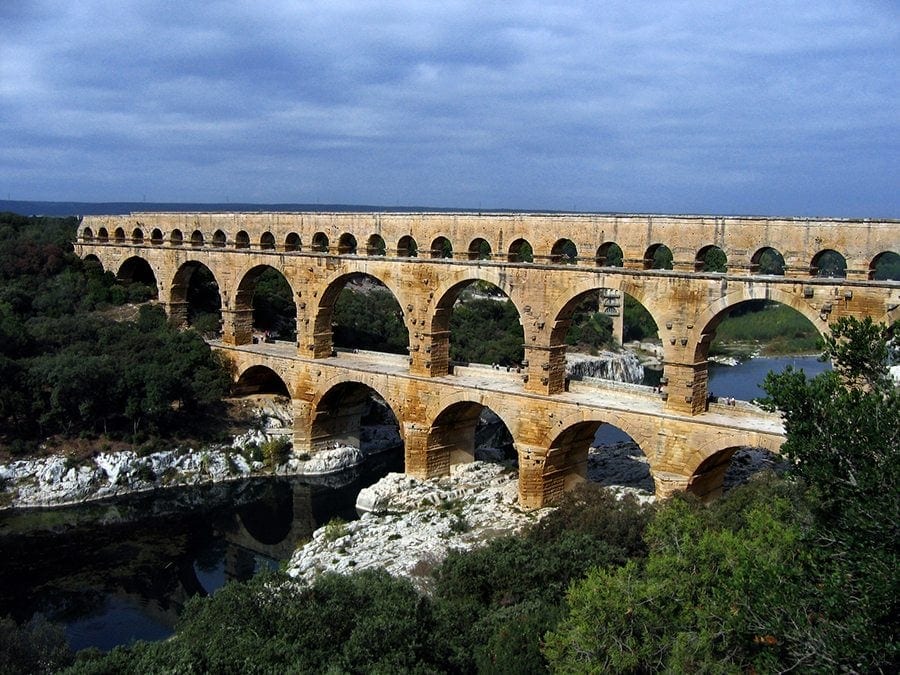A Brief History of Modern Plumbing

Plumbing is the system that moves fluids around for heating, cooling, waste removal, potable water etc. Plumbing uses pipes, valves, fixtures, tanks and other things to move fluids around. Plumbing infrastructure is critical to public health and sanitation. [Wikipedia]
Clean water and waste removal is long cited as one of the most important inventions in the modern world. It is almost unanimously accepted as having saved more lives than anything else in the world.
Have you thanked your plumber recently?
1700 BC
In Crete, Greece, the Minoan civilization used one of first sanitation and water supply systems. It used underground glass covered clay pipes for brining clean water and removing waste water. It even had a flushing toilet and storm sewage canals for overflow.
800 BC to 1st Century AD
The Roman Empire had sewers, public and private latrines, aqueducts and indoor plumbing. The first aqueduct was build in 312 BC and was a distribution system designed to bring clean water and dispose of waste water. Over the next few centuries, hundreds of aqueducts were built all over the Roman Empire.
Persia in the Middle East, the Qin and Hin Dynasties in China and the Classic Maya all used various forms of aqueducts, flushing toilets, water heating and cooling general plumbing. The Mayans even used porous limestone as a water filter.
1370
The first closed sewer is constructed in Paris on Monmarte Street.
1596
The first flush toilet is invented for Queen Elizabeth I.
1664
King Louis XIV had a cast-iron plumbing line constructed, carrying water 15 miles to Versailles.
17th Century
Castles have privies but lacked a waste disposal system and the plumbing dumped directly into surrounding moats and bodies of water.
1775
The S-trap is invented by Alexander Cummings. It uses standing water to seal the outlet of the bowl, which prevents the air from the sewer from escaping.
1804
Philadelphia is the first city to use all cast-iron pipes to create their new system of water delivery.
1829
The Tremont Hotel in Boston offers indoor plumbing and indoor water closets.
1848
England passes the National Public Health Act, this includes notes on water safety and is later adapted for most countries around the world.
1855
Chicago is the first American city to build a comprehensive sewer system to help control the spread and outbreak of diseases such as typhoid and cholera.
1860
Louis Pasteur uncovers the link between bacteria and disease.
1868
New York Metropolitan Board of Health forms to address the demand for a government study on disease and illnesses. It confirms the link between contaminated water and spread of disease. This leads to the development of sewage treatment systems to prevent water pollution which in turn leads to increases in life expectancy for urban populations.
1870
Private homes get water heaters.
1880
The first high tank water closets enter the market.
1906
William Elvis Sloan invents the Flushometer. This uses pressurized water to discharge water for waste removal rather than gravity.
1920
Elevated tank toilets, that are most like the toilets we know today, emerge onto the market.
1926
International Associate of Plumbing and Mechanical officials is founded. They begin the close t preserve public health and protect people from subpar plumbing practices.
1974
US passes the Safe Drinking Water Act
1984
the National Sanitation foundation and the American National Standards Instituted forms to test all fixtures that come into contact with potable water.
1988
US passes the Lead Contamination Control act
1992
Congress passes the Environmental Policy Act of 1992 to conserve water in toilets, faucets and shower heads. President George H. W. Bush signs it into law.
2007
NSF/ANSI reduces the amount of allowable lead in potable water fixtures.
2011
The Reduction of Lead in Drinking Water Act reducing lead content from 8% to .25%. President Obama signs it into law.
2015
The Sustainable Development Goals, officially known as “ Transforming our world: the 2030 Agenda for Sustainable Development”, includes targets on access to clean water and sanitation on a global level.
From the UN Website:
Goal 6: Ensure access to water and sanitation for all
Clean, accessible water for all is an essential part of the world we want to live in. There is sufficient fresh water on the planet to achieve this. But due to bad economics or poor infrastructure, every year millions of people, most of them children, die from diseases associated with inadequate water supply, sanitation and hygiene.
Water scarcity, poor water quality and inadequate sanitation negatively impact food security, livelihood choices and educational opportunities for poor families across the world. Drought afflicts some of the world’s poorest countries, worsening hunger and malnutrition.
Need HVAC Service?
Contact the experts at Eller Services.
Call us at 248-652-6650!